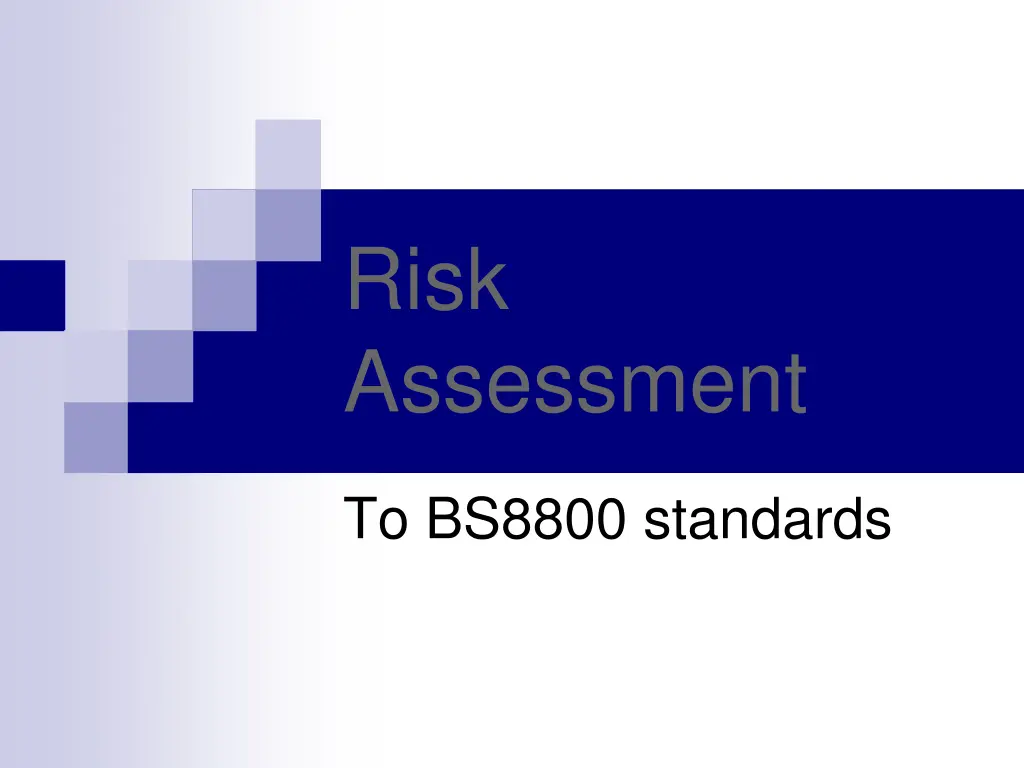
Understanding Risk Assessment and Management Standards
Explore the essentials of risk assessment and management, including principles, legal requirements, stages, and key considerations for effective risk assessment practices in compliance with BS8800 standards and relevant regulations.
Download Presentation

Please find below an Image/Link to download the presentation.
The content on the website is provided AS IS for your information and personal use only. It may not be sold, licensed, or shared on other websites without obtaining consent from the author. If you encounter any issues during the download, it is possible that the publisher has removed the file from their server.
You are allowed to download the files provided on this website for personal or commercial use, subject to the condition that they are used lawfully. All files are the property of their respective owners.
The content on the website is provided AS IS for your information and personal use only. It may not be sold, licensed, or shared on other websites without obtaining consent from the author.
E N D
Presentation Transcript
Risk Assessment To BS8800 standards
Principals of Risk Management The concept of risk assessment was made popular by the 1992 European directive on Health and Safety which, in the UK, resulted in the so called six pack regulations Risk management is usually defined as: The eradication or minimisation of the adverse affects of risks to which an organisation is exposed.
Health and safety at work act 1974 Section 2 It shall be the duty of every employer, to ensure, so far as is reasonably practicable, the health, safety and welfare at work of all his employees
Reasonable and Practical Low risk activities Possible fatal accidents
Regulation 3(1) of the Management of Health and Safety at Work Regulations 1992 states: Every Employer shall make a suitable and efficient assessment of: a) The risks to the health and safety of his employees to which they are exposed whilst they are at work. employment arising out of or in connection with the conduct by him or his undertaking; b) The risks to the health and safety of persons not in his
Stages in Risk Management Identifying the hazards Evaluating the associated risks. Controlling the risks.
Risk Assessment Requirements Must be suitable and sufficient Must correctly identify hazards Can disregards trivial risks Should determine the likelihood of injury Should quantify severity Should include existing control measures
Risk Assessment continued Should identify any specific legal duty Should remains valid for a reasonable time Should provide sufficient information to enable employers to decide on appropriate control measures Should enable employers to prioritise Must be recorded in writing!!
Risk Assessment ACCIDENT = Undesired event HAZARD = Ability to cause harm RISK = Probability of occurrence (Likelihood)
The Risk Management Process Hazard Identification Any hazard has: The potential to cause harm including ill health and injury, damage to property, plant, products or the environment, production losses or increased liabilities.
Assessing the Risks Risk: The likelihood that a specified undesired event will occur due to the realisation of a hazard by, or during work activities or by the products and services created by work activities.
Risk Assessment BS8800 SEVERITY 3) Extremely harmful 2) Harmful 1) Slightly harmful
Assessing the Risks Example: The likely effect of a hazard may for example be rated: Major Death or major injury or illness causing long term disability Serious Injuries or illness causing short-term disability Slight All other injuries or illnesses
Risk Assessment BS8800 LIKELIHOOD of event happening C) Likely B) Unlikely A) Highly unlikely
BS8800 Risk Assessment 1 2 3 A Trivial Tolerable Moderate B Tolerable Moderate Substantial C Moderate Substantial Intolerable
Risk assessment implementation Identify Evaluate Select Plan Program Implement Monitor Review The problem Alternative solutions Appropriate action How to tackle the job People, time, money The improvement The results It s effectiveness
